|
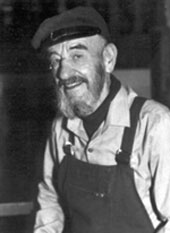 FIRST
off, Valentin Podpomogov is not an immigrant. Most likely,
he will never be. It's his pictures that are migrating
to America: in Los Angeles alone there are already more than a dozen
of them. FIRST
off, Valentin Podpomogov is not an immigrant. Most likely,
he will never be. It's his pictures that are migrating
to America: in Los Angeles alone there are already more than a dozen
of them.
He lives where he was born – Yerevan, the city where he was born. His
second name reveals that his father was Ukrainian – it's his mother who
was Armenian -- he considers himself to be a refined Armenian.
People in Yerevan say about him: “Valushka? He's the salt of Armenia”,
or “those who don’t know Podpomogov, don’t know Armenia”. Yes,
he is an Armenian artist; every cell in his body has absorbed the country's essence,
its culture, pride and pain. But let's look at his story from the beginning.
Valentin
was born long ago. In 1924. He grew up something of an idler, a loafer
who was reluctant to study. He even boasts of how he was kept back
in fourth grade for an extra year, before, to his relief, he was expelled. Since
then he never misses a chance of telling people that he has a fourth
grade education. And as regards to literacy “our Valushka” is
the second Pirosmanishvili (but only not regarding the style of painting
-- he is not a primitive, but even as some people assert, which by the
way I do not agree with, he is the Armenian Rembrandt). But a fourth grade
education never stopped him from becoming the art director of the Yerevan
city soviet.
Yet painting was not his first love: His biggest
artistic passion always was cinema (though even that came second
after drinking and carousing, at which he was an unsurpassed master).
For almost all his life Valya worked in the ”Armenfilm” film studio as
art director, creating a series of beautifully designed films. It was
in this field that we met, when, just after graduating from the Art-Theatrical
institute, I was made his assistant. The world of cinema seemed like
a fairy tale for me – made more unreal by the fact that I was working
with Podpomogov. I was very proud that my teacher at the institute was
the venerable sculptorAra Sarkissian, whose monumental statues embellish
the squares of Yerevan. But the training that I got with Podpomogov gave
me more than all the five years at the institute. He was a heaven-sent artist,
who never needed to study the teaching of anyone. You should have
seen him sketching plans for film sets!
After
getting his fee two months before filming began, he would immediately
go on a spree. A week would pass…then another …a month – and Valya, as
he would say himself – won’t “dry up”. It could seem to the people around
him that he was merely carousing. But somewhere, under his skull there
was serious work going on – the idea of the appearance of a future film
was being born, thought over and finally polished. And finally, a week,
sometimes even a day before the due time Valya would sit in front of the
plane-table. And the compositions wouldflow on the paper from under his
hand, appearing in such detail, that these would seem to be a photograph.
He seemed to be a genius at these moments, a conduit of the heavenly powers.
He was working like that 20 years ago, andhe lives and works the same
way now. And, by the way, he believes in parallel worlds, higher state
of consciousness, the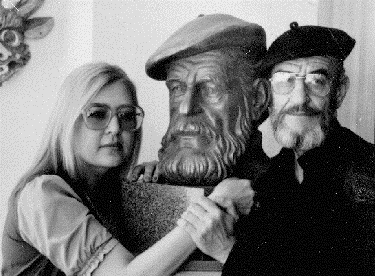 supernatural, in the way that only “connected” ones can believe
– the geniuses and big talents.
supernatural, in the way that only “connected” ones can believe
– the geniuses and big talents.
Podpomogov was a friend to the whole of Yerevan. People of different
professions, ages, and views would come to him. Beside him, they would
feel themselves to be in a different dimension. And if he was in the right
mood they would laugh till they were exhausted.
Valya, a man of weak constitution, almost feeble - “elegant-compact”,
was bald from youth. But he never had any complex about it; on
the contrary, he always played up his appearance. He permanently had a
beret or a cap hiding his bald head, but he never misses a chance to demonstrate
it with pride. And when for example he puts an old, crumpled hat and pulls
it down over his eyes, and wears four gloves on his hands and feet and
starts to jump over the room and screech pretending to be a scared monkey,
everyone will be laughing like a drain.
Valya was always sick of preciosity and stiffness, he would always think
of a trick or a joke to shock people. And his tricks were endless. It’s
not accidentally that his close friend for years was “the great joker”
Henri Hovhanessian, the director of the comedy film “Three plus Two”.
Valya has congenital heart disease. “No disease can kill me”
– he says –“I am preserved in alcohol”.
Another time an emergency was called for him, and the doctor asked
worriedly “Patient, what do you feel?”(and Valya's heart is pounding wildly,
with intermission). And the “patient”, pretending to be a drummer started
to beat on the table with his hands a discordant tattoo, demonstrating
his heart rhythm. Or, another time, when he was writhing in pain
on the floor with renal colic, he gave the doctor a tricky question “Doctor,
is this cancer?”
“No, my dear, it’s only stones,” comforted the doctor.
“Stones?”, -asked Valya, comically, cunningly squinting his eyes. “And
what’s under the stones?”
Whenever he was put in hospital it became a party for the whole
staff. Once, hospitalized over Easter, he decorated amazingly
beautiful eggs for all of them, and a poster appeared over the doors –
painted with typographical perfection -- with the following text:
“Soviet Union patients are the healthiest patients in the world!”
For two third of his life, Valya did everything but paint. Cinema,
cartoons, layout and design work. He was also an unsurpassed master of
decorative design. And taking into consideration, that he created everything
at the last moment before the deadline, you can imagine how nervous and
angry the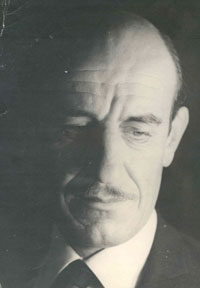 leadership of the republic became trying to catch him before the May and
November holidays. His endless fantasy and creativity had no boundaries.
leadership of the republic became trying to catch him before the May and
November holidays. His endless fantasy and creativity had no boundaries.
The best grave monuments in Yerevan cemetery are either personally
made by Valya or based on his sketches. There is so much elegance, taste
and mastery in everything that the hand of this seemingly unserious joker-idler
has touched. Everything is made with his hands both in his house and studio.
A fireplace with an embossed bas-relief of Prometheus, a bar decorated
with theatrical masks and a huge lobster in the center; stair-patterned
balusters. Style? Fin-de-seicle eclecticism with a hint of Middle
Ages. Real ancient weapons on the walls. Until Valya got a studio – and
he didn’t have one for quite a longtime - his flat served as one. His
wife and two children had to huddle in the corners of the flat, and the
center of the living room was constantly occupied by the workbench. The
floors were covered with sawdust, spots of paint and glue. Folks
tolerated everything without a sound, I would say devoutly. It seemed
that something unspoken was floating in the air: Everything is permissible
to Valya - he is a genius.
And when he finally got a studio – a damp basement without
windows or doors, but with rats -- and started to turn it into a masterpiece,
he absolutely forgot that he had a home and a family. He lived and worked
there. And his folks would come and visit him there. Though he would come
home on family occasions…with a bunch of friends in tow. For many years
we were persuading him to start painting seriously. But he would refuse.
But finally we managed to persuade him. He had lived a full half century
by then. (He went even better than Van Gogh, who started to paint when
he was already quite mature, but never even lived to Valya’s fifties).
He painted an amazingly expressive sad monkey, and called it “Nostalgia”.
Hismonkey astounded the whole of Yerevan. Since then, Valya has done nothing
but paint. Though he doesn’t paint as much as we'd like, and that’s
not because he's working hard and thoroughly on each painting. On the
contrary, he does everything very quickly, everything comes easily to
him (and even if he has difficulties, nobody knows about them). The reason
is that his drinking and socializing still comes first. His principle
is: friendship – is a round the clock notion. And the doors of his studio
are never cl osed
– despite his huge, black, satanic looking dog. Valya adores dogs. Many
years ago he had two boxer dogs. And when one of them was run over, the
best doctors of the city, the best surgeons, all of them his
close friends, carried out the surgery on his dog at his apartment, on
his dining table. osed
– despite his huge, black, satanic looking dog. Valya adores dogs. Many
years ago he had two boxer dogs. And when one of them was run over, the
best doctors of the city, the best surgeons, all of them his
close friends, carried out the surgery on his dog at his apartment, on
his dining table.
Valya is rich in friends, who are attracted to him by his great
charm. Today, in his studio, you can meet filmmakers and composers,
doctors and artists, scientists and young actors and actresses… Now they
all respectfully style Valya “the maestro”, but speak to him the same
friendly way. And, knowing Valya’s temper, this old fashioned and high-flown
word brings smile to peoples’faces.
Valya has dug more space under his studio and built there a medieval “bar
of horrors” for friends, complete with glowing skulls and scary masks,
among which is one made by me - the mask of Yama – the Indian god of death.
Oh, the talent of Valya Podpomogov! It’s usually vain to try to tell about
paintings with words. They must be not just “looked at”, but seen and
understood and lived. But Podpomogov’s paintings are somewhat different.
His paintings can be “told” like Shakespeare’s plays. All the paintings
that I will tell you about (and those which I won’t manage to tell about
as well) were born before my eyes. He would come to my studio to
share with an idea, start making sketches, always emotional and inspired.
Then he would disappear for some time and then appear again - this time
to call me to see his idea, finally realized in oils.
He paints in the style of the “old masters”. Color is secondary
for him: his palette is mainly silver-gray. The most important thing is
the idea. And everything is subjected to the idea – the line, the shape,
the style. His paintings are entire philosophical treatises, I would say
mystical, full of inner strength and drama.
Here for example on the big canvas we see a most monumental work
of human hands - conglomeration of nations and cultures, a conical tower,
with temples and pyramids of Egypt at the foot ….higher are Armenian Christian
temples and a lovingly detailed image of Zvartnots on a cloud... The tower
ends with crystals of modern skyscrapers, stretching to the sky. Above
the tower, like a crown of thorns, is an atomic mushroom cloud, which
has killed all the creators of this grand monument, built over many millennia.
Swarms of rats (which are not afraid of radiation) are rushing to the
deserted buildings. Mea Culpa.
Here are two mighty iron oxen dragging a plough, trying to turn
bare rock – this is the symbol of Armenia, tilled with hard work. “Strana
Hajastan” (“Country Armenia”).
Valya thinks that friendship can also enslave. And he created
a wonderful painting, encased in an ancient oval bronze fr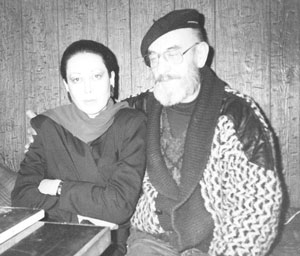 ame.
“In memory of a friend”. A skull of a noble horse with a long, carefully
brushed mane is painted with a touching expressiveness, like a traditional
social portrait. There is a bridle on the skull with a loop hang
on a hook and a horseshoe on the wall. What are these? Weapons of power
or love? ame.
“In memory of a friend”. A skull of a noble horse with a long, carefully
brushed mane is painted with a touching expressiveness, like a traditional
social portrait. There is a bridle on the skull with a loop hang
on a hook and a horseshoe on the wall. What are these? Weapons of power
or love?
“Funeral of God” – this is the original title; the painting appeared
in catalogues as Perpetual Motion. Covered with capes, bow-backed more
with grief than the burden, endless figures of people, stretching to the
horizon, are carrying the crucified Jesus. We see only his feet
and the strong beam of light, radiating from Jesus to the sky.
Valya uses the theme of God in his works several times, never recurring
the same way twice. Each time he finds new solution, different from anything
and anyone.
“Crucifix” – only the shell, the excoriated skin of the crucified
body is floating in the air. The soul has flown away, as a bird from a
destroyed nest.
Jesus on his knees is painted as detailed as a self-portrait (actually
it is a self-portrait). There are tears in Jesus’ eyes. Hands are stretchedto
the audience with a silent reproach full of pain: “People! What have you
done with the World entrusted to you?”
“The Last Supper” – light is pouring from above, and the shadow
of Jesus already has the crown of thorns on its head. Instead of 12 Apostles
on the left and on the right of Jesus there are candles and their shadows
on the walls are of people in capes. One of the candles has gone out and
smokes, the wisps wrapping around Jesus. This is certainly Judas.
The candle is a permanent element of Valya’s paintings, a sparkle of hope,
even in the most tragic, desperate situation.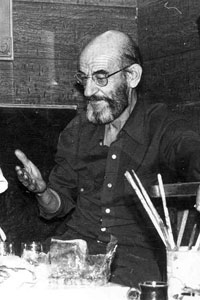
An apotheosis of the “symphony” of candles can be found in the painting
“Immortality”. Imagine a rocky road at night, stretching to the sky.
And only candles on the road, as strolling people are shimmering as stars
in distance. The burnt candle-ends on the foreground have merged into
a solid mass, and naked human bodies are visible in it. And a transparent
mighty candle burns over all of this, all along the height of the vertical
canvas. This is a hymn to the genius of mankind. Valya has dedicated this
picture to his adored Shakespeare, maybe because he is also a little bit
of a Shakespeare himself.
Podpomogov's pictures are usually a protest against injustice in all its
manifestations. “Struggle”. One more Crucifix? Yes. But this time the
Nature is crucified on the Crucifix of Civilization made of concrete.
A naked dry tree is writhing in its death throes, sinking the roots into
the crackled earth. It is still alive, it is still struggling.
Valya considers the frame to be an indispensable part of the picture;
its mounting but also its continuation. That’s why he makes them
himself. He can reproduce the texture of any material. If smoke – it visually
flows weightless and even smells like smoke. If cinder - it seems to burn
if you touch. Because of this, he's dismissed by some critics as a mere
craftsman, comparing him reproachfully with Shilov.
Podpomogov was deeply affected by the Armenian Genocide of 1915.
He dedicated several pictures to this. The most monumental of these is
the “Requiem”. A huge canvas. Pieces of ruined buildings standing
on flagstones (signs of civilization). A miraculously spared temple --
or rather its framework -- in the distance. A mighty, half
broken bell overthrown on the foreground. Wind is stirring up clouds of
dust. The site of fire is still smoking, making us, the w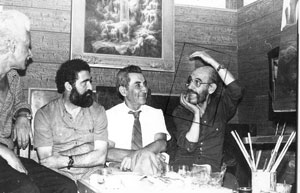 atchers,
participants of that time, that tragedy. The black sky is hanging over
the desecrated Earth. But in the very center, a heavenly window has opened
from between the clouds, and a divine light is pouring vigorously on Earth. atchers,
participants of that time, that tragedy. The black sky is hanging over
the desecrated Earth. But in the very center, a heavenly window has opened
from between the clouds, and a divine light is pouring vigorously on Earth.
When the troubles in Sumgait and Karabagh began, Podpomogov dedicated
to a series of emotionally saturated, grand and mournful, and certainly
very specific paintings, to these events.
It’s hard to associate Podpomogov’s works and their subjects with the
image of the person who creates them – the idler, the debauchee, the joker.
Which is the real one? As a biographical note I could say: of course the
one in his works. As an artist, he is lonely and dark in the depths of
his soul. And his real inside being is expressed in his works. And the
rest – is a mask…masquerade… disguise. But I won’t say anything of the
kind. Because I know him too well and for too long. He is equally sincere
and “acts himself”, both when he makes his friends to to exhaustion,
or creates paintings full of tragedy, which make you shiver and fear for
the future of mankind. An interesting detail – whatever Valya paints
(and he never paints from a model), in every work he paints himself, whether
it is his famous sad monkey in “Nostalgia” , or the “Homer”, sitting
comfortable in the keyhole, kneeling Jesus or the victim of the
Nazi concentration camp (“Consecration”), shot through the head. These
are all Valya, easily recognizable. Different everywhere, but always touching,
tragic and grand in his universal loneliness.
The bronze “Fire keeper” over his fire place and the Virgin with
child ( he painted it for the Holy See at Echmiadzin – but
the Catholicos decided in the end that Mary's eyes were too “wild”,
too sinful), and the crucified skin of Jesus - have similar hands and
feet – those of his, Valya’s. 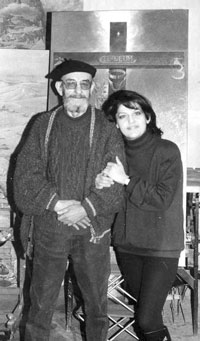
A
big round hall is given over to Podmomogov's paintings in the museum of
contemporary art in Yerevan. Most of the biggest Armenian collectors have
his paintings. From the very beginning, in the times of the convertible
“hard rouble”, they were sold for foreign currencies and the prices
for them flewup. The cheapest ones now cost several thousand dollars.
Today, Podpomogov is considered to be the most successful living artist
in Armenia.
People come to buy his works from Europe and America, try to smuggle
them through the customs. And here, inLA, there are even some fakes, passed
off as Podpomogov’s original works.
The art critic Henry Igitian, in his foreword to Valya’s catalogue, calls
him a man of a bygone generation. I cannot agree with that, and I amsure
that Valya himself does not agree with that. He may be one according to
the years he has lived, but not according to his spirit. And to disprove
his words I will tell about the last “trick” of our maestro. There was
a rumor between Armenians in LA, that Valya had died. I and my husband
rushed to call him at home. His daughter,Zheka, told us, that the rumors
about his death were somewhat exaggerated, but Valya was in the hospital.
We called him to the hospital. And what did we hear? “Congratulate me!”
– He shouted into the phone – I got married! We are spending a marvelous
time here in hospital!”
Remember, Rubens married Helena Furman, when he was 55, and she was 17.
Valya went better than the great Rubens. He is 72 in April! And his darling,
who has amazing eyes (Valya had a weakness for beautiful women eyes for
all his life), is a youthful girl who came five years ago to his studio,
and stayed there – having fallen madly in love with him. They live together
till now in that damp and cold basement, where in winter time frost glistens
on the walls.
Eleonora
Mandalian
"Panorama"
ALMANAC PANORAMA LOS ANGELES issue 805 Se, 1996
|